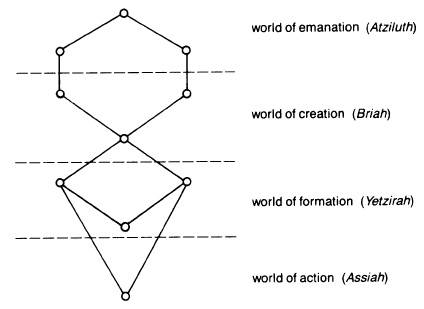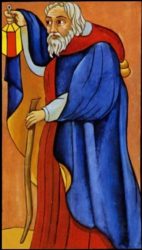Hope has two beautiful daughters; their names are Anger and Courage. Anger at the way things are, and Courage to see that they do not remain as they are. ~ St. Augustine of Hippo
As was mentioned in Salvation and Evolution last month, it is worthwhile to repeat this:
Our time makes an appeal to the collective endeavour of Hermetists of today to make a third summary, which will be for our time what the Tarot was for the Middle Ages and what the Emerald Tablet was for antiquity. Thus, just as the Emerald Tablet saved the essence of ancient wisdom, and just as the Tarot saved the essence of medieval wisdom, across the deluges which occurred in the time that separates us from them, may the essence of modern wisdom be saved in a spiritual “Noah’s ark” from the deluge which is going to come, and may it thereby be transmitted to the future, just as the essence of ancient wisdom and that of medieval wisdom has been transmitted to us by means of the Emerald Tablet and the Major Arcana of the Tarot. The tradition of Hermetism blossomed in the past and must live in the future. This is why a new, modern summary is required, which will be as viable as the Emerald Tablet and as the Major Arcana of the Tarot.
It is all too easy to forget that the intention of the Tarot is to preserve Hermetic wisdom. It is an example of objective art, since its symbolism will open itself up to those with the developed intuition to grasp its deeper meaning. Without that, the cards become subjective and arbitrary. So in “our time”, we see a multitude of variously themed decks of cards that have no connection at all to Hermetic teachings, but merely reflect the personal judgments of the artist.
In the Letter on the Fool, Valentin Tomberg reveals his experiences in 1920 with the group who had studied the Tarot with the Russian esoterist Gregory Ottonovitch Mebes. Although his claim to have surpassed their understanding of the Tarot is certainly true, the echoes of that original impulse can still be heard in the meditations.
The Spiritual Battle
Mouni Sadhu had also encountered some members of Mebes’ groups and even hinted at an initiation into the Martinist Order. His book on the Tarot is strongly based on the notes he had from that group. As such, that book is interesting as a framework for the Meditations. Sadhu’s book is analogous to the chord progression and the Meditations are like jazz riffs over those chords.

Each Arcanum in the Mebes Tarot deck has three levels of interpretation: archetype, human, nature. It also has a scientific name as well as a common name. For example, the full name of Arcanum 17 is the Star of the Magi. The Magi come up in passing in the Meditations through their gifts of gold, frankincense and myrrh.
The three levels of this Arcanum are:
- Hope
- Intuition
- Natural Divination
Each of these levels corresponds to the knowledge of the three cosmic forces explained by Fabre d’Olivet:
- Providence. Supernatural Hope is the knowledge of God’s promises.
- Will. Intuition is knowledge without thinking.
- Destiny. Also Fate or Karma. Natural Divination is our knowledge of the physical world.
This is how Sadhu describes this Arcanum:
It is not sufficient to be logically convinced under all circumstances, often Hope is necessary. It is not enough to enforce our will astrally, we should also have tact and intuition. It is not enough to know that Fate is pitiless on the physical plane, but it may be useful to know how to foresee its forms by the use of divinatory methods.
Alfred North Whitehead in Process and Reality describes how those forces interact to create new experiences. At each moment, the accumulation of the past exercises a strong influence to prevent change. God’s influence is also present as a creative, but not coercive, lure. Finally, the human Will acts on those possibilities of manifestation at each occasion.
Our knowledge of the physical world is through science and discursive thinking. However, intuition is our knowledge of higher things. That is why the Arcanum of the Star is about intuition, as it reveals aspects of Reality unknown to science. Sadhu explains:
Providence illuminates the present with its Light. … Hope acts and radiates its rays throughout the darkest corners of our consciousness.
Tomberg identifies this light with Hope:
The light-force which emanates from the star … is hope. … Hope is not something subjective. It is a light-force that radiates objectively and directs creative evolution towards the world’s future.
However, it does not act alone but requires humanity’s cooperation. Sadhu, too, recognizes human evolution, but only:
If humanity’s will is allied with the enlightening influence of Destiny, then it is stronger than Fate. In such cases, the history of humanity has an evolutionary character.
That is the only valid path. Unfortunately, there are false paths that lead to destruction: viz., denying the influence of Destiny, denying the voice of Providence, or even succumbing to Fate.
The latter keeps the will asleep, leading to resignation, routine, quietism, or fatalism. Dualism, on the other hand, awakens the will. Specifically, there must be a Yes and a No, the Will is forced to choose. Without the awareness of a spiritual battle, the Will remains asleep. Johann Fichte’s recognized this very clearly. Bryan Magee summarizes Fichte’s insight:
For morality to be possible there must be a choice, and for choice to be a possibility for me it is necessary that something should exist other than my self. Similarly, for moral action to be a possibility for me, there needs to be some challenge, something that exists in opposition to my self, or at least something that is a potential obstruction to my activity. So if I am to be a moral being at all it is necessary that there should be a world which is not me, a world of objects which can obstruct me. On the basis of this central argument Fichte evolved a philosophy according to which what is primal and original is the noumenal moral will, and this will begins into existence the phenomenal world as the requisite field for the self-objectification of moral activity.
This is represented by the two vases, which are poured into the same stream. Tomberg laments:
Here is the tragedy of human life and mankind’s history and cosmic evolution. The flow of continuity in heredity, tradition and lastly evolution bears not only all that which is healthy, noble, holy and divine of the past, but also all that which was infectious, vile, blasphemous and diabolical. All is borne pell-mell, never ending, towards the future.
There must be righteous Anger against the latter qualities, as well as the Courage to choose the former. Together, those are the daughters of Hope, which “transforms the future into promise.” That promise ultimately is the City of God, the state of Reintegration prior to the duality exposed by the Tree of the Knowledge of Good and Evil.
The Light of Hope
To live in the light of Hope is to reject the sleep of Fate. Fate is the Eternal Return, in which nothing is new, but is merely the Past repeating itself indefinitely. On the contrary, Tomberg reminds us:
Each day is a unique event and revelation which will never be repeated.
This is compatible with Rene Guenon’s claim that the same state of existence cannot be repeated, as that would be tantamount to the denial of God’s Infinitude.
Fortune Telling
The Patzer’s of Hermetism remain mired in the residues such as the various forms of Divination or the material tasks of the Alchemists. Mouni Sadhu acknowledges that “Everything in the Universe is mutually connected and bound together or interwoven.” Hope, Intuition, and Destiny – as we pointed out – occur at every moment. Regarding Fate or Karma, Sadhu acknowledges:
Karma reveals its mysteries and secrets to us every hour, every minute, and every second. For every one of us these mysteries are written in the starry sky (astrology), on our skulls (phrenology), on our faces (physiognomy) and on our hands (chiromancy). Karma unveils itself in every one of our movements, in the smallest of realisations (graphology, cartomancy) and so on.
The practice of these techniques requires an intuition to experience images. Although many may have such experiences, Sadhu points out that the main difficulty is not the obtaining of such visions, but rather the art of interpreting them. This is only possible through the full domination of the mind which requires the power of concentration. This is a rare quality.
Recently, I read a comment that claimed that someone with such divinatory powers would become wealthy. That shows an ignorance of the methods of the esoteric sciences, as she can conceive them only in the manner of the secular sciences, which are open to anyone. On the other hand, the mastery of the esoteric sciences requires the moral purification of the will. If such powers are used for egotistical motives or monetary gains, they are likely to be lost. Hence, the charging of money for Tarot card readings should be suspect.
Ultimately, Sadhu rejects such divinatory practices, because they are restricted to the level of Fate or Destiny. They leave out both the person’s free will and God’s Providence from the vision of the future.
The Synthesis of Science and Religion
Tomberg asserts that the synthesis of science and religion if the task and mission of Hermetism. Those who like to play at Hermetism remain obsessed with the early material tasks of the Alchemists: the philosopher’s stone, the elixir of life, the panacea, the transmutation of metals, all in their private laboratory. Tomberg offers an alternative.
It is the world which has become the alchemical laboratory, just as it has become the mystical oratory.
This is not the failure of alchemy, but rather its triumph. This new alchemy is the synthesis of salvation and evolution, which is expressed in three ways:
The work of all those who taught a way —
- the mystical and spiritual way of purification, illumination and union, or
- the historical and social way of the progress of civilisation through social and moral justice, or
- the biological way of evolution from the sphere of chemical elements to the sphere of living organisms and from the sphere of living organisms to that of beings endowed with thought and word
— the work of all these, I say, which teaches us a way of individual and collective perfection, is now resplendent in the rainbow of the synthesis of salvation and evolution, the rainbow of mankind’s hope.



